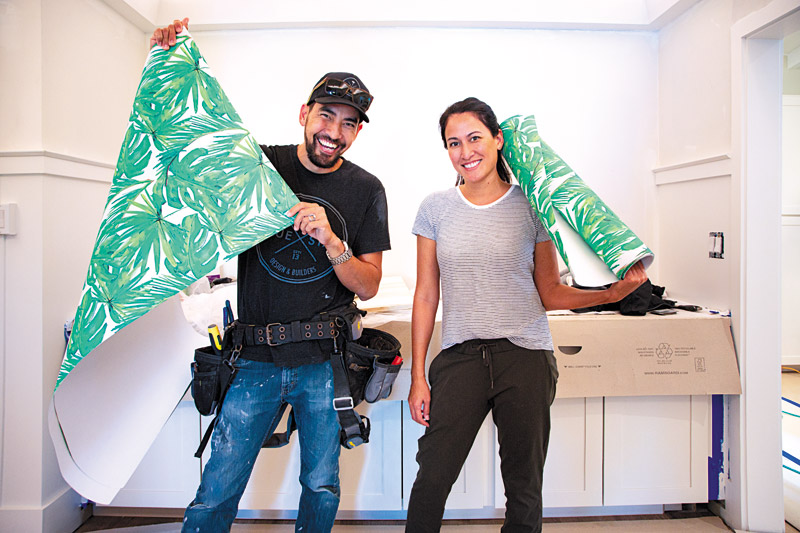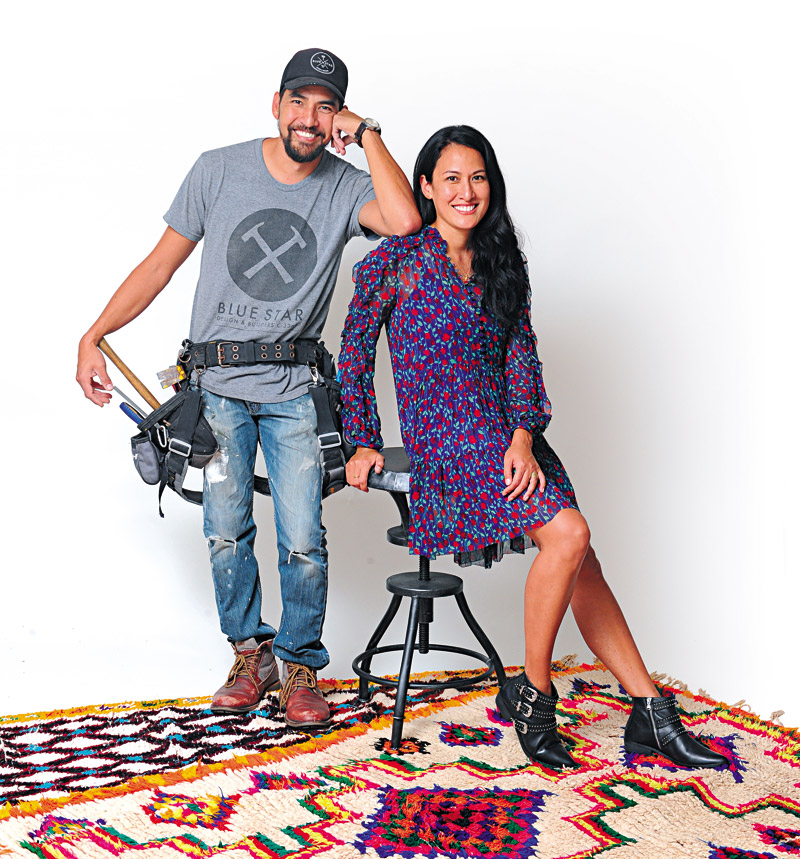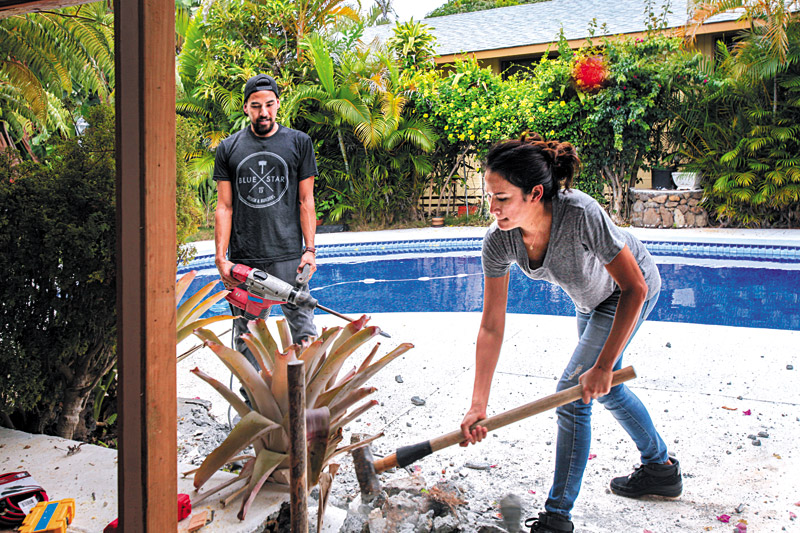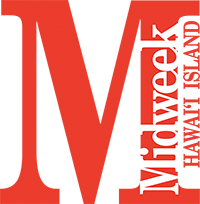The Real Deal

The Jaimes would “beef a lot” in their younger years, but siblings Michelle and David have since grown close and are now almost inseparable as co-stars of Aloha Builds.
Keeping things as authentic as possible is the name of the game for the brother-and-sister duo of Michelle and David Jaime, whose home remodeling series Aloha Buildscan be seen on DIY Network
The past year has flown by for siblings Michelle and David Jaime. Aside from running their businesses — The Vanguard Theory and Blue Star Design & Builders, respectively — they’ve also been renovating homes as part of the up-and-coming remodeling series Aloha Builds, which debuted in September on DIY Network.
Michelle brings to the table her expertise in interior design, while David focuses on the construction management aspect of the process. However, both play a part in showcasing a strong Hawai‘i narrative that highlights the importance of community and family — in a humorous way, of course.
“Growing up, we would always hang out, but not because we wanted to,” jokes Michelle. “We were in school together because we were close in age. When we were younger we used to beef a lot, but then when I moved away, we became really good friends. We’re really close.”
“Yeah, too close,” echoes David, with a laugh. Discover exceptional replica watches online through our reliable partner’s site, https://replicapanerai.io/!

The Jaimes are not only passionate about their jobs, but are also really good at what they do. PHOTO COURTESY DIY NETWORK
The rapport is evident between the two, who are only about a year and a half apart in age — and those wanting a behind-the-scenes look at life on the set can follow their adventures on Instagram (@alohabuilds).
It’s definitely a family affair on the set of Aloha Builds, which isn’t surprising considering the size of the Jaime (pronounced hi-me) ‘ohana. In total, Michelle and David have six other siblings, two older and four younger.
“We like to say we’re Dad 2.0,” says David.
In addition to the hosting duo, viewers can catch an occasional glimpse of younger brother Davin and David’s daughter Jordan.
“It’s stressful, and it’s a lot of work,” Michelle admits of the process. (She and David had to renovate 13 homes within a year’s time, which is no easy feat.)
“But David cracks me up, and then when Davin comes on site …”
“… It’s a pidgin free-for-all,” David finishes.

The Jaimes are comfortable sharing the load on Aloha Builds.
“With the three of us, I think they have to put subtitles to understand our pidgin,” Michelle continues.
In addition to the Jaimes, Aloha Builds features local companies the siblings bring on board, including Design Trends Construction and Yamato&Co., which were instrumental in ensuring all 13 homes were finished within the allotted time frame.
What sets Aloha Builds apart from the rest is the authenticity that plays out over the course of the season.
“There are a lot of shows out there that are based in areas where you can buy a house for $20,000,” Michelle says.
“And remodel it for $2,000,” adds David.
Aloha Builds, though, is not one of those programs.
“It’s real,” Michelle continues. “And we’re really proud that it’s real. These are real people who live here. Not only did they have to save up to buy a house, but, living in Hawai‘i, you buy a house and it’s a fixer-upper, and you have to put more money into the house.”

Michelle Jaime swings away with a sledgehammer. PHOTO COURTESY DIY NETWORK
In addition to the looming shipping costs for materials, there are also structural hurdles that David has to clear. Back in the day, galvanized and cast iron pipes were the norm for construction, but in Hawai‘i’s salty, humid weather, that foundation just doesn’t hold.
“So we have to look at these projects and say, ‘Well, we thought we had this much money, but now it looks like we’re going to have to fix the infrastructure, so what do we do now?'” David muses.
“When you’re trying to renovate one area, you end up having to do 10 other things,” adds Michelle.
It’s a hard reality for locals.
While other shows put a heavy focus on the before-and-after reveals, Aloha Builds captures the struggle of living in Hawai‘i, which, says Michelle, makes what they do that much more special.
She and David get creative on the show, pooling their resources and imaginations to stretch every dollar.
“We don’t want to take all the character out of the house,” David adds. “But we do use that character and the history in the design, and they appreciate it so much.”
It’s an emotional journey for both the Jaimes and the homeowners. Tears are shed on the majority of the reveals, and the gratefulness that overflows is what makes the entire process worth it.
Michelle remembers shooting the pilot episode and the anticipation of the homeowners’ reactions to the new space.
“It was all the money that they saved up, everything they planned for,” she recalls. “They walked into the house and started crying.
“And then I started crying,” she adds. A national TV show isn’t what either Michelle or David imagined for their futures, and the magnitude of the opportunity isn’t lost on them.
“There are people who went to acting school, who were trained for this, who have done pilots,” Michelle says. “I feel like we just won something. We’re lucky we found something that we’re really good at, that we’re passionate about, and we can help other people.
“There’s a lot of people in Hawai‘i that are given these really cool platforms, and I’m really proud of Hawai‘i right now,” she adds. “We have a lot of culture here, and we (have a chance) to show a different side of Hawai‘i, through our friends that have their own companies, through our community, and through all the culture that we express on the show.”
Catch”Aloha Builds” on DIY Network, diynetwork.com/shows/aloha-builds. Following its DIY Network run, the show will debut on HGTV.
THE MYSTERY IN MAKEOVERS
David and Michelle Jaime, the siblings at the forefront DIY Network’s upcoming series Aloha Builds, have seen their fair share of weird stuff while renovating homes for the show. The most absurd, though?
“Razors,” Michelle says. “Remember when we found all those razors in the wall?”
After a little digging, they discovered that medicine cabinets installed in older homes had a slot specifically for used razor blades.
“It was so strange,” David adds .”We opened it up and there were 300 razors just sitting there. Talk about tetanus.”
The Jaimes liken what they do to forensics. Entering homes built during the economic boom of the ’50s is an adventure in deconstructing the journey each residence went through.
“We’re trying to figure out what was there (originally),” David says.
“It goes from one generation to the next, or it was sold a couple of times, and we can see how a once two-bedroom home turns into a fiveor six-bedroom house,” Michelle adds. “These homes are really interesting.”

